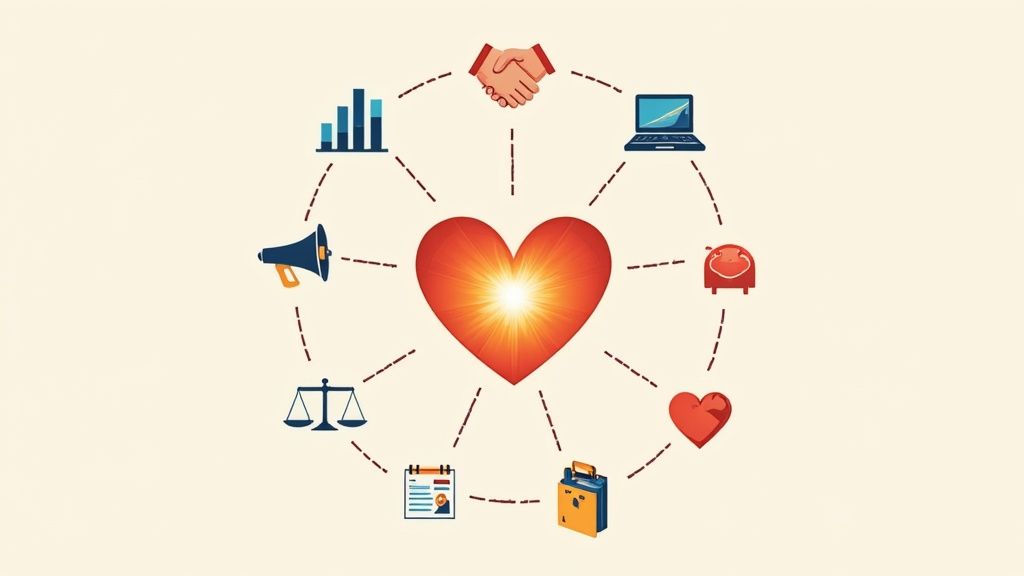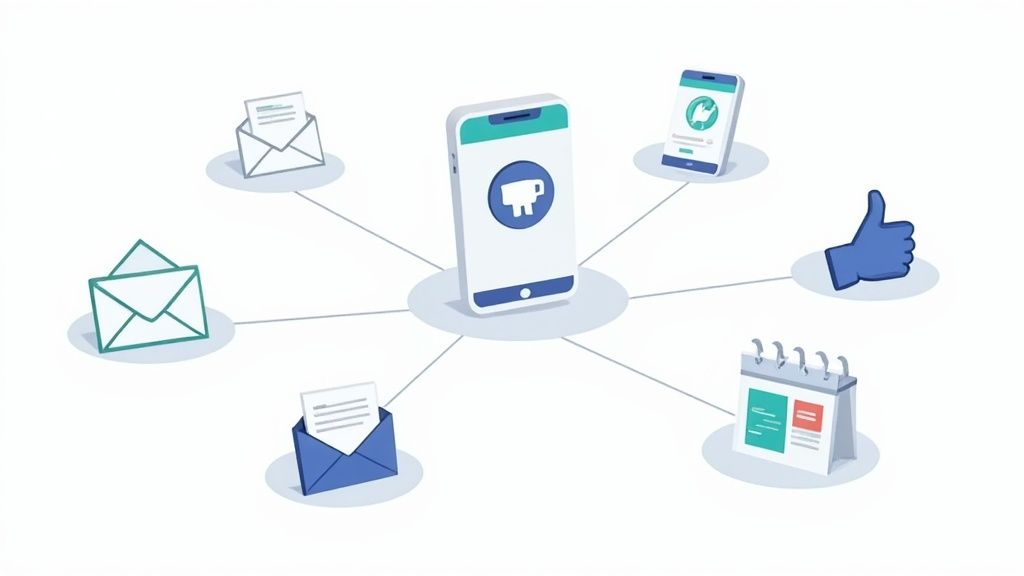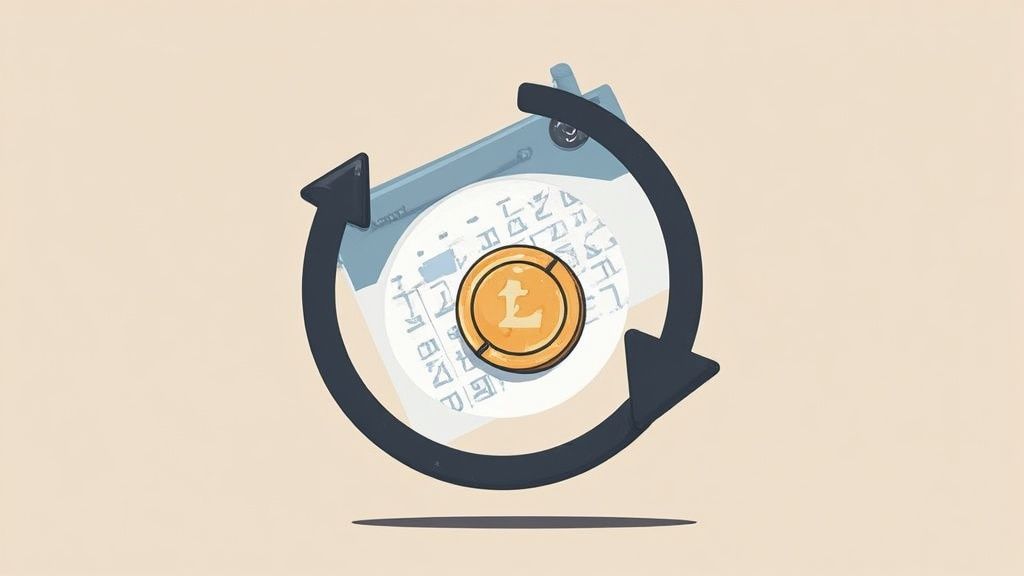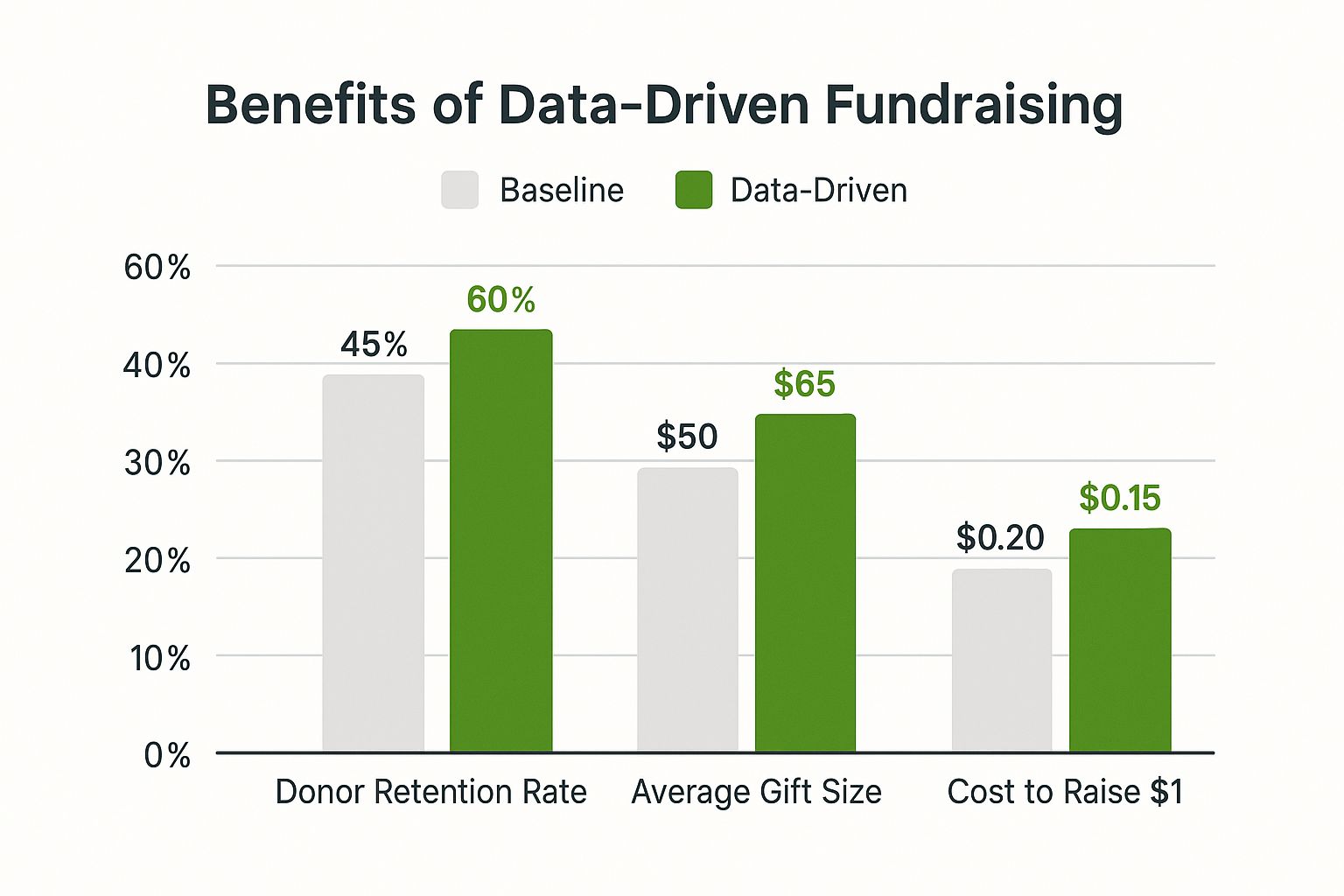9 Nonprofit Fundraising Best Practices for 2025
Discover 9 nonprofit fundraising best practices for 2025. Boost donor engagement and increase revenue with actionable strategies and expert tips.

In an increasingly competitive landscape, relying on outdated fundraising methods is a recipe for stagnation. To thrive, nonprofits must adopt proven strategies that build authentic relationships, demonstrate tangible impact, and leverage modern tools. Gone are the days when simple appeals were enough; today's donors expect sophistication, transparency, and a genuine connection to the causes they support. This guide moves beyond guesswork, unpacking nine essential nonprofit fundraising best practices designed to elevate your strategy and drive sustainable revenue.
We will explore actionable frameworks for every stage of the donor journey. From harnessing the power of donor-centric storytelling and building robust recurring giving programs to implementing data-driven decision-making, these insights are designed for immediate application. You will learn how to cultivate major donors strategically, create personalized communication that resonates, and report on your impact with clarity.
Each practice is a critical component of a holistic and effective fundraising engine. By mastering these techniques, your organization can create sustainable growth, deepen donor loyalty, and, most importantly, amplify your mission's reach. Let's explore the strategic pillars that separate good fundraising from great fundraising, providing you with the tools needed to secure the resources necessary to make a meaningful difference.
1. Donor-Centric Storytelling
One of the most powerful nonprofit fundraising best practices is shifting your narrative focus from your organization to your supporters. Donor-centric storytelling positions the donor as the hero of the story, transforming them from a passive giver into an active agent of change. This approach moves beyond simply stating your mission; it demonstrates how a donor’s specific contribution is the crucial link that creates a positive outcome. By connecting their generosity directly to impact, you forge a deeper, more emotional bond that fosters long-term loyalty.

Organizations like charity: water excel at this by showing donors the exact water project their funds supported, complete with photos and GPS coordinates. This specificity makes the impact feel tangible and personal.
How to Implement Donor-Centric Storytelling
Adopting this strategy requires a systematic approach to gathering, crafting, and sharing narratives. It’s about creating a feedback loop where donors see the results of their actions.
- Create a Story Bank: Systematically collect stories from program staff and beneficiaries. Use a simple framework like the Before-After-Bridge model: detail the problem (Before), show the transformation (After), and explain how the donor’s support was the Bridge that made it possible.
- Prioritize Ethical Collection: Always obtain informed consent before sharing an individual's story, photo, or personal details. Focus on preserving dignity and empowering the storyteller rather than exploiting their situation for fundraising gain.
- Use Specific, Authentic Details: Vague stories have little impact. Include real names (with permission), locations, and direct quotes to make the narrative more credible and relatable. This level of detail helps donors visualize the real-world effects of their support.
- Train Your Team: Ensure everyone from program managers to marketing staff understands the principles of ethical and effective storytelling.
2. Multi-Channel Integrated Campaigns
A cornerstone of modern nonprofit fundraising best practices is creating a cohesive donor journey across multiple platforms. Multi-channel integrated campaigns coordinate fundraising messages across email, social media, direct mail, and events to surround your audience with a consistent and compelling narrative. Instead of treating each channel as a silo, this approach ensures unified branding and timing, leveraging each platform's unique strengths to reach donors where they are most active. This synergy amplifies your message, reinforcing the call to action and making it easier for supporters to give.

Organizations like the American Red Cross master this during disaster response. They simultaneously deploy SMS alerts, email appeals, social media ads, and TV spots with coordinated messaging, creating an omnipresent and urgent call for support.
How to Implement Multi-Channel Integrated Campaigns
Successfully launching an integrated campaign requires careful planning and cross-team collaboration. The goal is to make the donor experience feel seamless and intuitive, no matter how they interact with your organization.
- Create a Campaign Calendar: Map out every touchpoint across all channels, including timing, core messaging, and calls to action. A centralized calendar ensures every team, from marketing to development, is perfectly aligned.
- Use a Centralized CRM: A robust Customer Relationship Management (CRM) system is critical for tracking donor interactions across different channels. This provides a 360-degree view of your supporters, allowing for more personalized and effective communication.
- Develop Channel-Specific Content: While the core message remains consistent, adapt the content to fit the platform. A heartfelt story might be best for an email, while a powerful statistic or short video works better on social media.
- Track and Measure Performance: Use UTM parameters for digital links and unique codes for direct mail to attribute donations to the correct channel. This data is essential for understanding which channel combinations drive the best results for your audience.
3. Monthly Recurring Giving Programs
One of the most sustainable nonprofit fundraising best practices is establishing a monthly recurring giving program. These programs, often called "sustainer" or "membership" programs, convert one-time donors into loyal supporters who give automatically each month. This strategy creates a predictable and reliable revenue stream, which is crucial for long-term planning and operational stability. By providing consistent funding, these programs empower organizations to focus more on their mission and less on short-term fundraising gaps.

Organizations like the ASPCA have mastered this with their 'Guardian' program, which generates a significant portion of their annual revenue. Similarly, Médecins Sans Frontières (MSF) engages their 'Field Partners' with regular updates, showing how steady support enables rapid emergency response and sustained medical care.
How to Implement a Monthly Recurring Giving Program
Building a successful sustainer program requires a strategic approach that emphasizes value, community, and consistent communication. It's about making donors feel like insiders who are vital to the organization's ongoing work. You can explore more about these and other sources of funding for nonprofits to diversify your strategy.
- Brand Your Program: Create an appealing name that fosters a sense of belonging, like 'Partners,' 'Guardians,' or a 'Founders Circle.' This branding helps differentiate monthly donors and makes them feel part of an exclusive group.
- Suggest Impact-Tied Amounts: Frame monthly giving options in terms of their annual impact (e.g., "$25 a month provides a year's worth of school supplies for a child"). This helps donors visualize the cumulative effect of their commitment.
- Provide Exclusive Content: Offer benefits unique to sustainers, such as quarterly impact reports, early access to event tickets, or special video messages from leadership. This reinforces the value of their ongoing support.
- Automate and Streamline: Use a robust CRM and payment processor to manage recurring payments and automate credit card update reminders. This minimizes lapses and reduces the administrative burden on your team.
4. Personalized Donor Communications
Moving beyond a "one-size-fits-all" approach is a cornerstone of modern nonprofit fundraising best practices. Personalized donor communications involve tailoring your messages, asks, and stewardship based on individual donor data, such as giving history, interests, and engagement levels. This practice transforms generic appeals into meaningful conversations by acknowledging a donor's unique relationship with your cause. Instead of simply inserting a first name, true personalization uses data to make each supporter feel seen, understood, and valued as a unique partner in your mission.
Animal welfare organizations often excel at this by sending appeals that reference a donor's interest in a specific type of animal, like cats or dogs, or by sending updates on a previously funded rescue. This targeted approach demonstrates that the organization is paying attention and deepens the donor's personal connection to the work.
How to Implement Personalized Donor Communications
Effective personalization relies on good data and a strategic plan to segment your audience and tailor your outreach. It’s about using what you know to build stronger relationships.
- Start with Smart Segmentation: Begin by grouping your donors into logical segments. Common starting points include new donors, monthly givers, lapsed supporters, and major donors. Each group has different motivations and requires a distinct communication style and ask.
- Leverage Giving History: Use past donation data to inform future asks. A simple and effective tactic is to suggest a specific gift amount based on their last contribution, often with a modest 15-25% increase, to encourage upgraded support.
- Track Engagement and Interests: Monitor how donors interact with your organization. Note which emails they open, which website pages they visit, and which events they attend. Use surveys to directly ask about their programmatic interests to gather more explicit data for personalization.
- Automate Thoughtfully: Use your CRM or email platform to set up if-then rules for automated personalization. For example, a donor who gives to a specific campaign can automatically be tagged to receive detailed impact reports related to that project.
5. Transparent Impact Reporting
Transparent impact reporting is the practice of openly and regularly sharing how donations are used, the specific outcomes achieved, and how your organization measures success. This moves beyond simply stating your mission; it involves providing concrete proof that contributions are making a tangible difference. By demonstrating this level of accountability, you build profound donor trust and answer the fundamental question every supporter asks: “Where did my money go, and what did it accomplish?” This transparency is a cornerstone of modern nonprofit fundraising best practices.
Organizations like the Against Malaria Foundation have mastered this by tracking every single net distributed, providing detailed usage reports, and connecting donations directly to the reduction of malaria cases. This specificity provides donors with undeniable proof of impact.
How to Implement Transparent Impact Reporting
Effective reporting requires a commitment to collecting and sharing data in a clear, honest, and accessible way. It transforms financial statements and program statistics into a compelling narrative of change.
- Create an Annual Impact Report: Develop a flagship stewardship document that combines financial data, program metrics, beneficiary stories, and data visualizations. This report should be easily accessible on your website and shared widely with your supporters.
- Define Clear, Measurable Outcomes: Before launching a program, establish specific, measurable outcomes that align with your mission. Use a framework like the Logic Model (inputs, activities, outputs, outcomes, impact) to structure your measurement process and report on results at each stage.
- Make Financials Accessible: Publish your Form 990, audited financial statements, and a simple breakdown of how funds are allocated (e.g., program vs. administrative costs) on your website. Transparency in this area builds immense credibility.
- Be Honest About Challenges: True transparency includes sharing what didn't work. Discussing failures, lessons learned, and how you are adapting your strategy shows maturity and builds a deeper, more authentic trust with your donors.
6. Strategic Major Donor Cultivation
One of the most impactful nonprofit fundraising best practices involves shifting from broad appeals to a focused, relationship-driven strategy. Strategic major donor cultivation moves beyond transactional asks to build authentic, long-term connections with individuals who have the capacity to make a significant impact. This approach is founded on shared values, matching a donor's philanthropic passions with your organization's most pressing needs and creating a partnership rather than just a donation. By investing in these key relationships, you unlock transformational gifts that can accelerate your mission.
Universities excel at this by engaging alumni through reunion giving campaigns and offering naming opportunities for new facilities. Similarly, environmental organizations often take major donors on site visits to conservation projects, making the impact of their potential gift tangible and inspiring.
How to Implement Strategic Major Donor Cultivation
A successful major gifts program is systematic and personalized. It requires a clear process for identifying prospects, nurturing relationships, and providing meaningful stewardship.
- Create a Moves Management System: Use your CRM to track every interaction, or "move," with a potential major donor. Document meetings, calls, and emails to ensure timely follow-up and strategically plan the 5-7 meaningful touches often needed before making a solicitation.
- Qualify Your Prospects: Focus your efforts on donors with Capacity (ability to give), Affinity (connection to your mission), and Inclination (a history of philanthropic behavior). Use wealth screening tools for initial research but always verify findings through personal conversations.
- Involve Your Leadership: Engage your executive director, board members, and other key volunteers in the cultivation process. A meeting with the CEO or a call from a board member can be a powerful touchpoint that demonstrates the donor's importance to the organization.
- Practice the 80/20 Rule: In meetings, spend 80% of the time listening to your donor's interests, values, and motivations. This deep understanding allows you to tailor your ask to a project they are passionate about, making it feel less like a solicitation and more like an opportunity.
7. Data-Driven Decision Making
One of the most transformative nonprofit fundraising best practices is shifting from intuition-based strategies to data-driven decision making. This approach involves systematically collecting, analyzing, and applying donor and campaign data to inform strategy, optimize performance, and allocate resources effectively. By using metrics, A/B testing, and performance benchmarking, you can make evidence-based choices on everything from campaign timing to donor segmentation, creating a culture of continuous improvement through measurement and learning.
Organizations like DonorsChoose leverage data to personalize project recommendations for donors based on their giving history, dramatically increasing engagement and repeat donations. This precision turns fundraising from a guessing game into a science.
How to Implement Data-Driven Decision Making
Adopting a data-first mindset requires the right tools, processes, and a commitment to learning from the numbers. It's about asking the right questions and letting the data guide your answers.
- Establish Key KPIs: Start by tracking 3-5 essential metrics. Focus on your donor retention rate, average gift size, cost to raise a dollar, and donor lifetime value (LTV). These provide a clear snapshot of your fundraising health.
- Implement a CRM: A robust donor database or Customer Relationship Management (CRM) system is non-negotiable. It allows you to track every interaction, gift, and communication, providing the raw data needed for analysis.
- Conduct A/B Tests: Systematically test one variable at a time in your campaigns, such as an email subject line, a call-to-action button color, or a donation ask amount. The Obama campaigns famously pioneered this technique, using data to optimize their fundraising appeals with significant impact.
- Build Data Capacity: Train your team on basic data literacy and interpretation. You can also explore nonprofit capacity building grants to fund investments in technology and staff development.
The bar chart below visualizes the potential impact of applying a data-driven approach compared to a baseline, showcasing improvements in key fundraising metrics.

This visualization highlights how informed strategies can lead to a 15% increase in donor retention while simultaneously lowering the cost to raise each dollar.
8. Rapid Response and Urgency Campaigns
One of the most effective nonprofit fundraising best practices is creating a sense of immediacy through time-sensitive campaigns. Rapid response and urgency campaigns capitalize on current events, deadlines, or matching gift opportunities to create a compelling reason for supporters to donate now. This strategy leverages urgency psychology, combining clear deadlines with emotional immediacy to drive quick, decisive action and can generate significant revenue in a very short timeframe.
The American Red Cross demonstrates this powerfully, often raising millions within days of a major natural disaster by clearly communicating the immediate need for aid. Similarly, Giving Tuesday campaigns leverage a single day of collective generosity to create a powerful, time-bound fundraising moment.
How to Implement Rapid Response and Urgency Campaigns
A successful urgency campaign requires careful preparation and swift, coordinated execution. The goal is to make giving feel both critical and easy.
- Be Authentic and Specific: Use urgency truthfully. Don’t fabricate crises. Clearly articulate the specific, time-sensitive need (e.g., “We need to raise $10,000 by Friday to secure the matching grant”) and explain exactly how funds will be used.
- Simplify the Donation Process: When asking for immediate action, you must remove all barriers. Use one-click donation links in emails and ensure your mobile donation page loads in under three seconds. Every extra step can lead to abandonment.
- Create Visual Progress Indicators: Use fundraising thermometers, goal counters, and countdown clocks on your website and social media. Visualizing progress motivates donors and creates a sense of shared effort as the deadline approaches.
- Prepare in Advance: Don't wait for a crisis to start from scratch. Develop rapid response templates for your website, email, and social media channels. Having these assets ready allows your team to launch a campaign within hours, not days.
9. Donor Retention and Stewardship Programs
Acquiring a new donor can be up to five times more expensive than retaining an existing one. This reality makes robust donor retention and stewardship programs one of the most critical nonprofit fundraising best practices. Stewardship is the systematic process of thanking, updating, and engaging donors after they give, building a lasting relationship that transcends a single transaction. This focus on nurturing existing supporters is far more cost-effective than constant acquisition and significantly increases a donor's lifetime value, turning one-time givers into lifelong advocates.
Organizations like Heifer International master stewardship by sending donors detailed project updates that show the specific animals delivered and families impacted by their contribution. This direct feedback loop reinforces the value of their support and encourages repeat giving.
How to Implement Donor Retention and Stewardship
Building an effective stewardship program involves creating a structured, multi-touch communication plan that makes donors feel valued and informed between fundraising asks. The goal is to cultivate a relationship, not just process a donation.
- Implement Prompt and Personal Gratitude: Send a personalized thank-you communication within 48 hours of receiving a gift. This initial acknowledgment sets the tone for the entire relationship. Go beyond a generic receipt; a handwritten note, a personal email from a leader, or a short video can have a profound impact.
- Create a Welcome Series: Develop an automated welcome journey for first-time donors to onboard them within their first 90 days. This series should introduce them to your work, show their initial impact, and offer non-financial ways to engage, like following on social media or volunteering.
- Segment Your Stewardship Efforts: Not all donors should be treated the same. Develop tiered stewardship plans based on giving levels, frequency, or other factors. A major donor might receive a personal call from a board member, while a monthly giver might get exclusive impact reports.
- Report on Impact Consistently: Regularly provide donors with updates on what their support has accomplished. Use newsletters, annual reports, and personalized emails to close the loop and demonstrate that their investment is making a tangible difference. This is a key element of effective nonprofit fundraising.
Best Practices Comparison of 9 Fundraising Strategies
Turning Best Practices into Everyday Practice
The journey through the landscape of modern fundraising reveals a clear, compelling truth: success is no longer about just asking for money. It is about building a sustainable ecosystem of support, driven by authentic connection, strategic foresight, and measurable impact. Moving from theory to action is where the real work begins, transforming these nonprofit fundraising best practices from a checklist into the very DNA of your organization's culture.
This guide has explored a powerful suite of strategies, from the emotional resonance of donor-centric storytelling to the analytical precision of data-driven decision-making. We’ve seen how creating multi-channel integrated campaigns and nurturing monthly recurring giving programs can build a broad, reliable base of support. At the same time, the deep, personal engagement required for strategic major donor cultivation and the appreciative follow-through of robust donor stewardship programs are what elevate one-time givers into lifelong advocates for your cause.
Weaving Strategy into Your Daily Workflow
Adopting these principles is a commitment to continuous improvement. It means viewing every interaction as an opportunity to strengthen a relationship and every piece of data as a signpost guiding your next move. The key is to avoid treating these practices as isolated projects. Instead, they must be integrated into your team's daily operations and strategic planning sessions.
Key takeaways to prioritize include:
- Humanize Your Mission: Place authentic stories and transparent impact reporting at the core of all your communications. Donors connect with people and outcomes, not just statistics.
- Personalize at Scale: Leverage your data to tailor communications. A donor's history, interests, and engagement level should directly inform how you speak to them, making them feel seen and valued.
- Diversify and Integrate: Relying on a single fundraising channel is a significant risk. A healthy program integrates major gifts, recurring donations, digital campaigns, and grants into a cohesive, year-round strategy.
- Invest in Retention: The most cost-effective fundraising you will ever do is keeping the donors you already have. Make stewardship and gratitude a primary function, not an afterthought.
The Synergy of Strategy and Technology
Embracing these nonprofit fundraising best practices is not merely about working harder; it is about working smarter. The true potential of these strategies is unlocked when your team is empowered by the right technology. Manual tracking, fragmented data, and endless administrative tasks can stifle the very creativity and relationship-building that these practices demand.
By implementing platforms designed to automate tedious processes, you free your team to focus on what truly matters: connecting with supporters, refining your message, and executing your mission with excellence. Combining a powerful strategic framework with efficient technology creates a fundraising engine that is not only effective but also resilient and scalable. This powerful synergy ensures your organization is equipped to meet today's challenges and seize tomorrow's opportunities, driving your impact for years to come.
Ready to supercharge your grant-seeking efforts and put these best practices into action? Fundsprout uses AI to help you find the perfect funding opportunities, write compelling grant proposals in a fraction of the time, and manage your entire pipeline effortlessly. Discover how technology can amplify your impact by visiting Fundsprout today.
Try 14 days free
Get started with Fundsprout so you can focus on what really matters.
